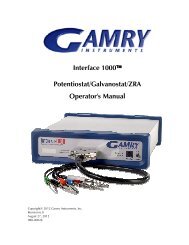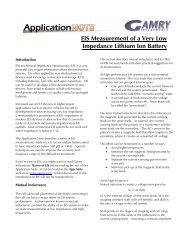Basics of Electrochemical Impedance Spectroscopy - Gamry ...
Basics of Electrochemical Impedance Spectroscopy - Gamry ...
Basics of Electrochemical Impedance Spectroscopy - Gamry ...
Create successful ePaper yourself
Turn your PDF publications into a flip-book with our unique Google optimized e-Paper software.
Figure 1. Sinusoidal Current Response in a Linear<br />
System<br />
The excitation signal, expressed as a function <strong>of</strong> time,<br />
has the form<br />
E = E sin( t)<br />
t 0 ω (2)<br />
where E t is the potential at time t, E 0 is the amplitude<br />
<strong>of</strong> the signal, and ω is the radial frequency. The<br />
relationship between radial frequency ω (expressed in<br />
radians/second) and frequency f (expressed in hertz) is:<br />
ω = 2π f (3)<br />
In a linear system, the response signal, I t , is shifted in<br />
phase (φ) and has a different amplitude, I 0 .<br />
I = I sin ( t + )<br />
t 0 ω φ (4)<br />
An expression analogous to Ohm's Law allows us to<br />
calculate the impedance <strong>of</strong> the system as:<br />
Z<br />
Et<br />
E0 sin( ω t)<br />
= =<br />
= Z<br />
I I sin( ω t + φ)<br />
t<br />
0<br />
0<br />
sin( ω t)<br />
sin( ω t + φ )<br />
(5)<br />
The impedance is therefore expressed in terms <strong>of</strong> a<br />
magnitude, Z o , and a phase shift, φ.<br />
If we plot the applied sinusoidal signal E(t) on the X-axis<br />
<strong>of</strong> a graph and the sinusoidal response signal I(t) on the<br />
Y-axis, the result is an oval (see Figure 2). This oval is<br />
known as a "Lissajous Figure". Analysis <strong>of</strong> Lissajous<br />
Figures on oscilloscope screens was the accepted<br />
2<br />
method <strong>of</strong> impedance measurement prior to the<br />
availability <strong>of</strong> modern EIS instrumentation.<br />
Figure 2. Origin <strong>of</strong> Lissajous Figure<br />
With Eulers relationship,<br />
exp( j φ) = cos φ + jsinφ<br />
(6)<br />
it is possible to express the impedance as a complex<br />
function. The potential is described as,<br />
and the current response as,<br />
E = E exp( j t)<br />
t 0 ω (7)<br />
I = I exp( j t - )<br />
t 0 ω φ (8)<br />
The impedance is then represented as a complex<br />
number,<br />
E<br />
Z( ω) = = Z0exp( j φ) = Z 0 (cos φ + jsinφ)<br />
I<br />
(9)<br />
Data Presentation<br />
Look at Equation 8 in the previous section. The<br />
expression for Z(ω) is composed <strong>of</strong> a real and an<br />
imaginary part. If the real part is plotted on the X-axis<br />
and the imaginary part is plotted on the Y-axis <strong>of</strong> a<br />
chart, we get a "Nyquist Plot" (see Figure 3). Notice that<br />
in this plot the Y-axis is negative and that each point on<br />
the Nyquist Plot is the impedance at one frequency.<br />
Figure 3 has been annotated to show that low frequency




